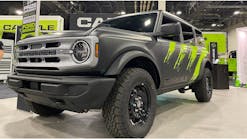If you’re scratching your head over what you need to consider regarding all the new and emerging automotive technologies, I-CAR technical director Jason Bartanen has a one-word answer: training.
“Training – along with tools, equipment and technical information – is an essential tool for properly repairing today’s vehicles,” he says.
“Training is the quickest way to find out what’s new,” says Bartanen, who taught a Friday session “Repair Considerations for New & Emerging Automotive Technologies” for NACE attendees.
“You can spend hours and hours researching new vehicle designs and technologies, or you can leverage existing training sources to do the research for you.”
A lot of the old repair rules are changing, according to Bartanen. “When vehicles were primarily mild steel, they were more repairable. With advanced high-strength steel (AHSS), the amount of repair is more limited. Heat cannot be used for straightening; heat will adversely affect the steel strength. If ultra high-strength steel (UHSS) is added to a side of a vehicle to ensure a five-star crash rating and heat is used to straighten it, how many stars will that decision reduce?” he ponders by way of a warning.
“General sectioning may no longer be applicable in many situations due to a number of reasons. More OEM sectioning procedures are available, there are many areas that have been strengthened – reinforced – to enhance occupant protection, and through design techniques such as AHSS and tailored blanks, collapse zones may not be as recognizable,” Bartanen says.
“Vehicles are actually getting heavier, not lighter,” he explains. “So a new car hitting a barrier at 40 mph has to dissipate more collision energy than a 10-year-old vehicle.”
However, Bartanen notes, “that 10-year-old vehicle offered a number of visual clues to assist in determining how far that collision energy traveled.” Panel gaps, roof damage and quarter panel buckles were good indicators.
“Today’s vehicle lacks many of those clues,” he continues. “Door gaps are often unaffected in a frontal collision, and buckles may not be evident. The question is: Where did that collision energy go? In order to perform a complete and thorough damage analysis, it will likely be necessary to get the vehicle up and measure it.”
Of course, it is entirely possible to overcome any hurdles presented by this new OEM technology.
“Knowledge is key,” says Bartanen. “It’s important to know what you’re working on, identify how far the damage has traveled, and develop a complete repair plan using vehicle maker information and following all available procedures.”
He stresses that “more procedures exist today than ever before; there is no excuse not to use the procedures that exist.”
One of the many twists facing repairers is how kink versus bent has changed. “HSS and UHSS parts that would be termed ‘bent’ may likely not be able to be straightened. Minor deformation on an UHSS B-Pillar may require replacement.”
Investments in additional equipment are therefore critical to keep a shop up and efficiently running, Bartanen said.
“A squeeze-type resistant spot welder is an essential tool for late-model collision damaged vehicles,” he says. “Another essential – and still underused – tool is vehicle maker repair information. I-CAR has always said to follow the vehicle maker’s recommendations.
“More procedures exist today than ever before, and they can easily be accessed,” he says. “As far as a return on investment, I’d go back to the five-star rating. How comfortable are you with taking a vehicle with a five-star impact and fixing it the way you always have?


